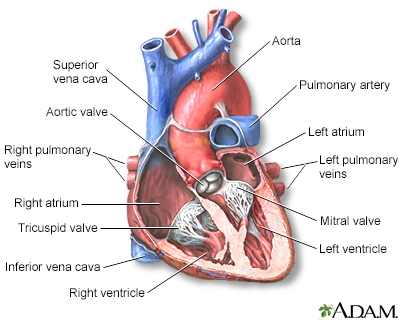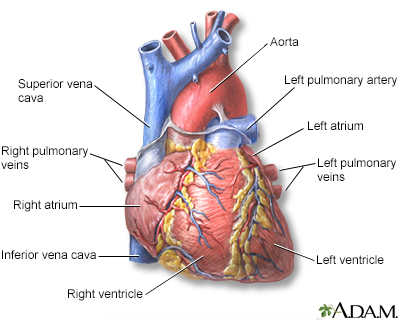Myocarditis
Inflammation - heart muscle
Myocarditis is inflammation of the heart muscle.
The condition is called pediatric myocarditis when it occurs in children.
Images



Causes
Myocarditis is an uncommon disorder. Most of the time, it is caused by an infection that reaches the heart.
When you have an infection, your immune system produces special cells to fight off disease. If the infection affects your heart, the disease-fighting cells enter the heart. However, the chemicals made by these cells can also damage the heart muscle. As a result, the heart can become thick, swollen, and weak.
Many cases are caused by a virus that reaches the heart. These can include the SARS-CoV-2 virus (the virus that causes COVID-19), influenza (flu) virus, coxsackievirus, parvovirus, cytomegalovirus, adenovirus, and others.
It may also be caused by bacterial infections such as Lyme disease, streptococcus, mycoplasma, and chlamydia.
Other causes of myocarditis include:
- Reactions to certain medicines, such as certain chemotherapy medicines
- Exposure to chemicals in the environment, such as heavy metals
- Infections due to fungus or parasites
- Radiation
- Autoimmune disorders that cause inflammation throughout the body
- Myocarditis following COVID-19 vaccination has been reported, but is very rare
Sometimes the exact cause may not be discovered.
Symptoms
There may be no symptoms. Symptoms may be similar to the flu. If symptoms occur, they may include:
- Chest pain that may resemble a heart attack
- Fatigue or listlessness
- Fever and other signs of infection including headache, muscle aches, sore throat, diarrhea, or rashes
- Joint pain or swelling
- Leg swelling
- Pale, cool hands and feet (a sign of poor circulation)
- Rapid breathing
- Rapid heart rate
- Shortness of breath
Other symptoms that may occur with this disease include:
- Fainting, often related to irregular heart rhythms
- Low urine output
Exams and Tests
Myocarditis can be hard to diagnose because the signs and symptoms often mimic those of other heart and lung diseases, or a bad case of the flu.
The health care provider may hear a rapid heartbeat or abnormal heart sounds while listening to the person's chest with a stethoscope. A physical exam may detect fluid in the lungs and swelling in the legs.
There may be signs of infection, including fever and rashes.
A chest x-ray can show enlargement (swelling) of the heart. If the provider suspects myocarditis based on the exam and chest x-ray, an electrocardiogram (ECG) may also be done to help make the diagnosis. Heart biopsy is the most accurate way to confirm the diagnosis, but it is not always needed. Also, a heart biopsy may not reveal the diagnosis if the small piece of heart tissue that is removed does not contain the suspected organism or other indicators. Echocardiography (heart ultrasound) and cardiac MRI are also frequently used.
Other tests that may be needed include:
- Blood cultures to check for infection
- Blood tests to look for antibodies against viruses or the heart muscle itself
- Blood tests to check liver and kidney function
- Complete blood count
- Special tests to check for the presence of viruses in the blood (viral PCR)
Treatment
Treatment is aimed at the cause of the problem, and may involve:
- Antibiotics to fight bacterial infection
- Medicines called steroids to reduce swelling
- Intravenous immunoglobulin (IVIG), a medicine made of substances (called antibodies) that the body produces to fight infection, which may control the inflammatory process
- Diuretics to remove excess water from the body
- Low-salt diet
- Reduced activity
If the heart muscle is weak, your provider will prescribe medicines to treat heart failure. Abnormal heart rhythms may require the use of other medicines. You may also need a device such as a pacemaker, or implantable cardioverter-defibrillator to correct a dangerous abnormal heartbeat. If a blood clot is in the heart chamber, you will also receive blood thinning medicine.
Rarely, a heart transplant may be needed if the heart muscle has become too weak to function.
Outlook (Prognosis)
The outcome can vary, depending on the cause of the problem and a person’s overall health. Some people may recover completely. Others may have lasting heart failure.
Possible Complications
Complications may include:
- Cardiomyopathy
- Heart failure
- Heart rhythm problems
- Pericarditis
When to Contact a Medical Professional
Contact your provider if you have symptoms of myocarditis, especially after a recent infection.
Seek medical help right away if:
- Your symptoms are severe.
- You have been diagnosed with myocarditis, and you have increased chest pain, swelling, or breathing problems.
Prevention
Treat conditions that cause myocarditis promptly to reduce the risk.
Related Information
PolioFlu
Rubella
Heart failure
Pericarditis
Cardiomyopathy
References
Centers for Disease Control and Prevention. Safety of COVID-19 vaccines. www.cdc.gov/coronavirus/2019-ncov/vaccines/safety/safety-of-vaccines.html. Updated November 3, 2023. Accessed February 29, 2024.
Cooper LT, Knowlton KU. Myocarditis. In: Libby P, Bonow RO, Mann DL, Tomaselli GF, Bhatt DL, Solomon SD, eds. Braunwald's Heart Disease: A Textbook of Cardiovascular Medicine. 12th ed. Philadelphia, PA: Elsevier; 2022:chap 55.
Elliott PM, Olivotto I. Diseases of the myocardium and endocardium. In: Goldman L, Cooney KA, eds. Goldman-Cecil Medicine. 27th ed. Philadelphia, PA: Elsevier; 2024:chap 47.
Knowlton KU, Anderson JL, Savoia MC, Oxman MN. Myocarditis and pericarditis. In: Bennett JE, Dolin R, Blaser MJ, eds. Mandell, Douglas, and Bennett's Principles and Practice of Infectious Diseases. 9th ed. Philadelphia, PA: Elsevier; 2020:chap 84.
BACK TO TOPReview Date: 2/27/2024
Reviewed By: Thomas S. Metkus, MD, Assistant Professor of Medicine and Surgery, Johns Hopkins University School of Medicine, Baltimore, MD. Also reviewed by David C. Dugdale, MD, Medical Director, Brenda Conaway, Editorial Director, and the A.D.A.M. Editorial team.

Health Content Provider
06/01/2025
|
A.D.A.M., Inc. is accredited by URAC, for Health Content Provider (www.urac.org). URAC's accreditation program is an independent audit to verify that A.D.A.M. follows rigorous standards of quality and accountability. A.D.A.M. is among the first to achieve this important distinction for online health information and services. Learn more about A.D.A.M.'s editorial policy, editorial process and privacy policy. A.D.A.M. is also a founding member of Hi-Ethics. This site complied with the HONcode standard for trustworthy health information from 1995 to 2022, after which HON (Health On the Net, a not-for-profit organization that promoted transparent and reliable health information online) was discontinued. |
The information provided herein should not be used during any medical emergency or for the diagnosis or treatment of any medical condition. A licensed medical professional should be consulted for diagnosis and treatment of any and all medical conditions. Links to other sites are provided for information only -- they do not constitute endorsements of those other sites. © 1997- 2025 A.D.A.M., a business unit of Ebix, Inc. Any duplication or distribution of the information contained herein is strictly prohibited.
